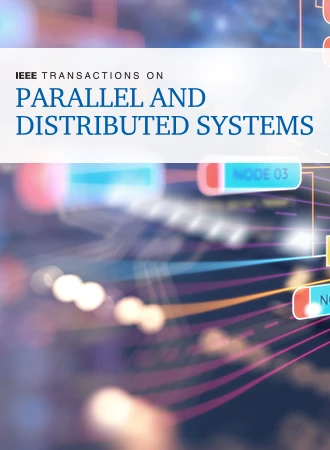Object Proxy Patterns for Accelerating Distributed Applications
IF 6
2区 计算机科学
Q1 COMPUTER SCIENCE, THEORY & METHODS
IEEE Transactions on Parallel and Distributed Systems
Pub Date : 2024-12-04
DOI:10.1109/TPDS.2024.3511347
引用次数: 0
Abstract
Workflow and serverless frameworks have empowered new approaches to distributed application design by abstracting compute resources. However, their typically limited or one-size-fits-all support for advanced data flow patterns leaves optimization to the application programmer—optimization that becomes more difficult as data become larger. The transparent object proxy, which provides wide-area references that can resolve to data regardless of location, has been demonstrated as an effective low-level building block in such situations. Here we propose three high-level proxy-based programming patterns—distributed futures, streaming, and ownership—that make the power of the proxy pattern usable for more complex and dynamic distributed program structures. We motivate these patterns via careful review of application requirements and describe implementations of each pattern. We evaluate our implementations through a suite of benchmarks and by applying them in three meaningful scientific applications, in which we demonstrate substantial improvements in runtime, throughput, and memory usage.加速分布式应用程序的对象代理模式
工作流和无服务器框架通过抽象计算资源为分布式应用程序设计提供了新的方法。然而,它们对高级数据流模式的支持通常是有限的或一刀切的,这将优化留给了应用程序编程人员——随着数据变大,优化变得更加困难。透明对象代理提供了广域引用,可以解析到任何位置的数据,已被证明是这种情况下有效的低级构建块。在这里,我们提出了三种高级的基于代理的编程模式——分布式未来、流和所有权——它们使代理模式的强大功能可用于更复杂和动态的分布式程序结构。我们通过仔细审查应用程序需求来激发这些模式,并描述每个模式的实现。我们通过一套基准测试来评估我们的实现,并在三个有意义的科学应用程序中应用它们,在这些应用程序中,我们展示了在运行时、吞吐量和内存使用方面的重大改进。
本文章由计算机程序翻译,如有差异,请以英文原文为准。
求助全文
约1分钟内获得全文
求助全文
来源期刊

IEEE Transactions on Parallel and Distributed Systems
工程技术-工程:电子与电气
CiteScore
11.00
自引率
9.40%
发文量
281
审稿时长
5.6 months
期刊介绍:
IEEE Transactions on Parallel and Distributed Systems (TPDS) is published monthly. It publishes a range of papers, comments on previously published papers, and survey articles that deal with the parallel and distributed systems research areas of current importance to our readers. Particular areas of interest include, but are not limited to:
a) Parallel and distributed algorithms, focusing on topics such as: models of computation; numerical, combinatorial, and data-intensive parallel algorithms, scalability of algorithms and data structures for parallel and distributed systems, communication and synchronization protocols, network algorithms, scheduling, and load balancing.
b) Applications of parallel and distributed computing, including computational and data-enabled science and engineering, big data applications, parallel crowd sourcing, large-scale social network analysis, management of big data, cloud and grid computing, scientific and biomedical applications, mobile computing, and cyber-physical systems.
c) Parallel and distributed architectures, including architectures for instruction-level and thread-level parallelism; design, analysis, implementation, fault resilience and performance measurements of multiple-processor systems; multicore processors, heterogeneous many-core systems; petascale and exascale systems designs; novel big data architectures; special purpose architectures, including graphics processors, signal processors, network processors, media accelerators, and other special purpose processors and accelerators; impact of technology on architecture; network and interconnect architectures; parallel I/O and storage systems; architecture of the memory hierarchy; power-efficient and green computing architectures; dependable architectures; and performance modeling and evaluation.
d) Parallel and distributed software, including parallel and multicore programming languages and compilers, runtime systems, operating systems, Internet computing and web services, resource management including green computing, middleware for grids, clouds, and data centers, libraries, performance modeling and evaluation, parallel programming paradigms, and programming environments and tools.
 求助内容:
求助内容: 应助结果提醒方式:
应助结果提醒方式:


